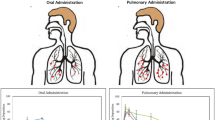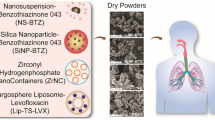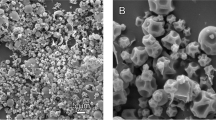Abstract
Isoxyl is a potent antituberculosis drug effective in treating various multidrug-resistant strains in the absence of known side effects. Isoxyl has been used exclusively, but infrequently, via the oral route and has exhibited very poor and highly variable bioavailability due to its sparing solubility in water. These properties resulted in failure of some clinical trials and, consequently, isoxyl’s use has been limited. Delivery of isoxyl to the lungs, a major site of Mycobacterium tuberculosis infection, is an attractive alternative route of administration that may rescue this abandoned drug for a disease that urgently requires new therapies. Particles for pulmonary delivery were prepared by antisolvent precipitation. Nanofibers with a width of 200 nm were obtained by injecting isoxyl solution in ethanol to water at a volume ratio of solvent to antisolvent of 1:5. Based on this preliminary result, a well-controlled method, involving nozzle mixing, was employed to prepare isoxyl particles. All the particles were 200 to 400 nm in width but had different lengths depending on properties of the solvents. However, generating these nanoparticles by simultaneous spray drying produced isoxyl microparticles (Feret’s diameter, 1.19–1.77 μm) with no discernible nanoparticle substructure. The bulking agent, mannitol, helped to prevent these nanoparticles from agglomeration during process and resulted in nanoparticle aggregates in micron-sized superstructures. Future studies will focus on understanding difference of these isoxyl microparticles and nanoparticles/nanoparticle aggregates in terms of in vivo disposition and efficacy.







Similar content being viewed by others
References
WHO. World Health Organization report: global tuberculosis control—epidemiology, strategy, financing. Geneva: WHO; 2009.
Frieden TR, Sterling TR, Munsiff SS, Watt CJ, Dye C. Tuberculosis. Lancet. 2003;362(9387):887–99.
Gelperina S, Kisich K, Iseman MD, Heifets L. The potential advantages of nanoparticle drug delivery systems in chemotherapy of tuberculosis. Am J Respir Crit Care Med. 2005;172(12):1487–90.
Bastian I, Colebunders R. Treatment and prevention of multidrug-resistant tuberculosis. Drugs. 1999;58(4):633–61.
Skeiky YA, Sadoff JC. Advances in tuberculosis vaccine strategies. Nat Rev Microbiol. 2006;4(6):469–76.
Kimerling ME, Phillips P, Patterson P, Hall M, Robinson CA, Dunlap NE. Low serum antimycobacterial drug levels in non-HIV-infected tuberculosis patients. Chest. 1998;113(5):1178–83.
Conte Jr JE, Golden JA, McQuitty M, Kipps J, Duncan S, McKenna E et al. Effects of gender, AIDS, and acetylator status on intrapulmonary concentrations of isoniazid. Antimicrob Agents Chemother. 2002;46(8):2358–64.
Tappero JW, Bradford WZ, Agerton TB, Hopewell P, Reingold AL, Lockman S et al. Serum concentrations of antimycobacterial drugs in patients with pulmonary tuberculosis in Botswana. Clin Infect Dis. 2005;41(4):461–9.
Muttil P, Wang C, Hickey AJ. Inhaled drug delivery for tuberculosis therapy. Pharm Res. 2009;26:2401–16.
Hwang SM, Kim DD, Chung SJ, Shim CK. Delivery of ofloxacin to the lung and alveolar macrophages via hyaluronan microspheres for the treatment of tuberculosis. J Control Release. 2008;129(2):100–6.
Davies NM, Feddah MR. A novel method for assessing dissolution of aerosol inhaler products. Int J Pharm. 2003;255(1–2):175–87.
Patton JS, Fishburn CS, Weers JG. The lungs as a portal of entry for systemic drug delivery. Proc Am Thorac Soc. 2004;1(4):338–44.
Makino K, Nakajima T, Shikamura M, Ito F, Ando S, Kochi C et al. Efficient intracellular delivery of rifampicin to alveolar macrophages using rifampicin-loaded PLGA microspheres: effects of molecular weight and composition of PLGA on release of rifampicin. Colloids Surf B Biointerfaces. 2004;36(1):35–42.
Phetsuksiri B, Baulard AR, Cooper AM, Minnikin DE, Douglas JD, Besra GS et al. Antimycobacterial activities of isoxyl and new derivatives through the inhibition of mycolic acid synthesis. Antimicrob Agents Chemother. 1999;43(5):1042–51.
Isoxyl. Tubercle. 1965;46(3):298–300.
Tousek J. On the clinical effectiveness of isoxyl. Antibiot Chemother. 1970;16:149–55.
Bartmann K, editor. Antituberculosis drugs. Berlin: Springer-Verlag; 1988. p. 185–9.
Mitchell RS, Petty TL, Dye WE. Clinical and pharmacological studies of isoxyl. In Transactions of the 23rd Research Conference in Pulmonary Disease; 1964.
Wang Z, Chen JF, Le Y, Shen ZG, Yun J. Preparation of ultrafine beclomethasone dipropionate drug powder by antisolvent precipitation. Ind Eng Chem Res. 2007;46(14):4839–45.
Patton JS, Byron PR. Inhaling medicines: delivering drugs to the body through the lungs. Nat Rev Drug Discov. 2007;6(1):67–74.
Tam JM, McConville JT, Williams 3rd RO, Johnston KP. Amorphous cyclosporin nanodispersions for enhanced pulmonary deposition and dissolution. J Pharm Sci. 2008;97:4915–33.
Ahsan F, Rivas IP, Khan MA, Torres Suarez AI. Targeting to macrophages: role of physicochemical properties of particulate carriers–liposomes and microspheres–on the phagocytosis by macrophages. J Control Release. 2002;79(1–3):29–40.
Sharma R, Saxena D, Dwivedi AK, Misra A. Inhalable microparticles containing drug combinations to target alveolar macrophages for treatment of pulmonary tuberculosis. Pharm Res. 2001;18(10):1405–10.
Sharma R, Muttil P, Yadav AB, Rath SK, Bajpai VK, Mani U et al. Uptake of inhalable microparticles affects defence responses of macrophages infected with Mycobacterium tuberculosis H37Ra. J Antimicrob Chemother. 2007;59(3):499–506.
Tam JM, McConville JT, Williams 3rd RO, Johnston KP. Amorphous cyclosporin nanodispersions for enhanced pulmonary deposition and dissolution. J Pharm Sci. 2008;97(11):4915–33.
Matteucci ME, Hotze MA, Johnston KP, Williams 3rd RO. Drug nanoparticles by antisolvent precipitation: mixing energy versus surfactant stabilization. Langmuir. 2006;22(21):8951–9.
Mullin JW. Crystallization. 4th ed. Oxford: Butterworth-Heinemann; 2001.
Adamson AW. Physical chemistry of surfaces. 5th ed. New York: Wiley; 1990.
Park SJ, Yeo SD. Antisolvent crystallization of sulfa drugs and the effect of process parameters. Sep Sci Technol. 2007;42:2645–60.
Cal K, Sollohub K. Spray drying technique. I: Hardware and process parameters. J Pharm Sci. 2010;99:575–86.
Larhrib H, Martin GP, Marriott C, Prime D. The influence of carrier and drug morphology on drug delivery from dry powder formulations. Int J Pharm. 2003;257(1–2):283–96.
Stanton MF, Layard M, Tegeris A, Miller E, May M, Morgan E et al. Relation of particle dimension to carcinogenicity in amphibole asbestoses and other fibrous minerals. J Natl Cancer Inst. 1981;67(5):965–75.
Barrett JC, Lamb PW, Wiseman RW. Multiple mechanisms for the carcinogenic effects of asbestos and other mineral fibers. Environ Health Perspect. 1989;81:81–9.
Blake T, Castranova V, Schwegler-Berry D, Baron P, Deye GJ, Li C et al. Effect of fiber length on glass microfiber cytotoxicity. J Toxicol Environ Health A. 1998;54(4):243–59.
Zeidler-Erdely PC, Calhoun WJ, Ameredes BT, Clark MP, Deye GJ, Baron P et al. In vitro cytotoxicity of Manville Code 100 glass fibers: effect of fiber length on human alveolar macrophages. Part Fibre Toxicol. 2006;3:5.
Zhao H, Le Y, Liu H, Hu T, Shen Z, Yun J et al. Preparation of microsized spherical aggregates of ultrafine ciprofloxacin particles for dry powder inhalation (DPI). Powder Technol. 2009;194:81–6.
Haleblian JK. Characterization of habits and crystalline modification of solids and their pharmaceutical applications. J Pharm Sci. 1975;64(8):1269–88.
Vehring R. Pharmaceutical particle engineering via spray drying. Pharm Res. 2008;25(5):999–1022.
Chow AH, Tong HH, Chattopadhyay P, Shekunov BY. Particle engineering for pulmonary drug delivery. Pharm Res. 2007;24(3):411–37.
Muller RH, Jacobs C, Kayser O. Nanosuspensions as particulate drug formulations in therapy. Rationale for development and what we can expect for the future. Adv Drug Deliv Rev. 2001;47(1):3–19.
Hickey AJ. Inhalation aerosols: physical and biological basis for therapy. 2nd ed. New York: Informa Healthcare; 2006.
Caira M, Crider M, de Villers M, Liebenberg W. New synthesis and physicochemical properties of two crystal forms of the antitubercular agent isoxyl. In: AAPS Annual Meeting and Exposition; 2005.
Bhowruth V, Brown AK, Reynolds RC, Coxon GD, Mackay SP, Minnikin DE et al. Symmetrical and unsymmetrical analogues of isoxyl; active agents against Mycobacterium tuberculosis. Bioorg Med Chem Lett. 2006;16(18):4743–7.
Hinds WC. Aerosol technology: properties, behavior, and measurement of airborne particles. 2nd ed. New York: Wiley; 1998.
Dunbar CA, Hickey AJ, Holzner P. Dispersion and characterization of pharmaceutical dry powder aerosols. KONA. 1998;16:7–44.
Hickey AJ. Pharmaceutical inhalation aerosol technology, vol. 2. New York: Marcel Dekker Inc; 2003 (revised and expanded).
Zeng XM, Martin AP, Marriott C, Pritchard J. The influence of carrier morphology on drug delivery by dry powder inhalers. Int J Pharm. 2000;200(1):93–106.
Acknowledgements
Scanning electron microscopy was conducted at the Analytical and Nanofabrication Laboratory (CHANL) and the School of Dentistry, University of North Carolina at Chapel Hill. We gratefully acknowledge the assistance of Carrie Donley and Wallace Ambrose.
Author information
Authors and Affiliations
Corresponding author
Rights and permissions
About this article
Cite this article
Wang, C., Hickey, A.J. Isoxyl Aerosols for Tuberculosis Treatment: Preparation and Characterization of Particles. AAPS PharmSciTech 11, 538–549 (2010). https://doi.org/10.1208/s12249-010-9415-y
Received:
Accepted:
Published:
Issue Date:
DOI: https://doi.org/10.1208/s12249-010-9415-y




